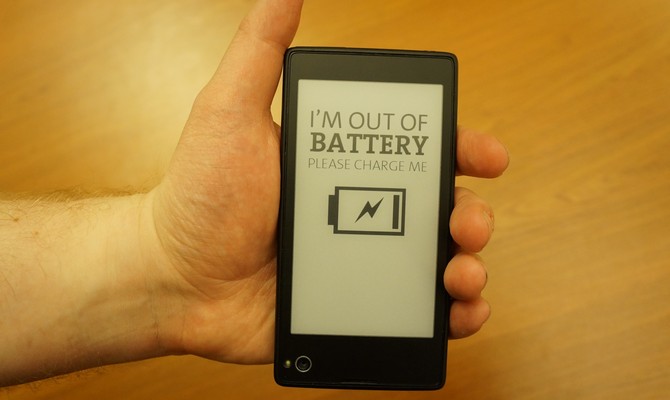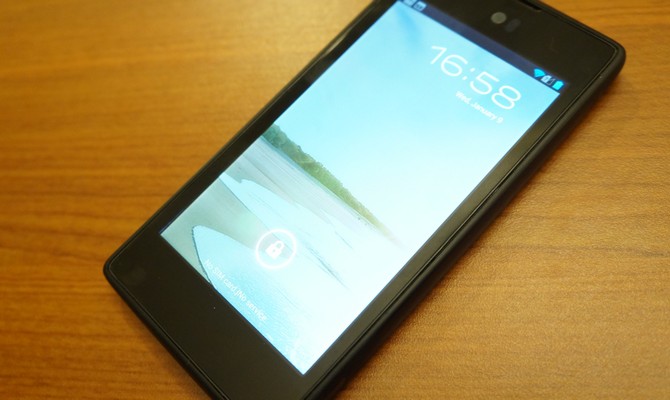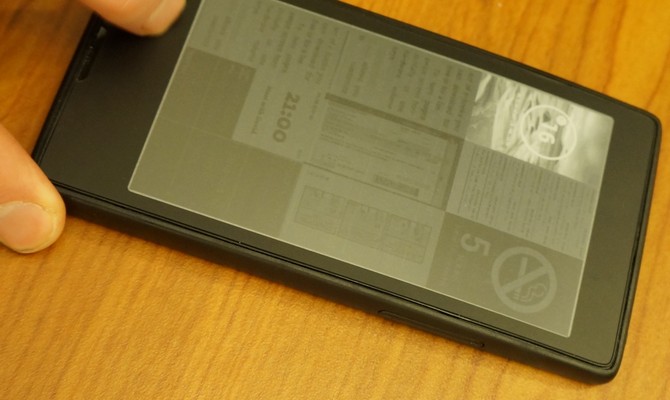Smart It Is: Yota Phone's E-Paper Screen Shows Content on the Back
When we first heard about the Yota phone, a 4.3-inch Android phone with a grayscale e-Paper display on the back, we were puzzled but intrigued by the concept. But after seeing a working prototype here at CES, we're excited about the new range of use cases this second screen presents. In an extensive private demo at CES, Yota COO Lau Geckler showed us how the back screen can serve as an eReader, an always-present alert system or a post-it note for your digital life.
Premise: Always On, Easily Glanceable
In the days before smartphones, we had to turn on our computers just to find out if we had an important email. Now we have smartphones, but we still have to wake them to see our most important alerts. Because EPD screens only use power when they change, you can keep your alerts on the grayscale display and glance at them without hitting the power button to light up the display. Imagine leaving the phone face down on a table and staring discretely at your Facebook feed while you ignore your boring relatives at Thanksgiving. Picture yourself walking around a city with a map that can stay visible on the back of the screen while you walk around
Hardware and Design
The Yota Phone's front surface does not look remarkable in any way, with its glossy black bezel, HD webcam and 4.3-inch Super LCD, 720p screen. The sides contain a a 3.5mm audio jack, volume buttons, a magnetic charging connector (instead of micro USB) and a power button that doubles as the Sim card slot cover. The backside holds the ePaper screen, which gently slopes downward because of its special, flexible Gorilla Glass display.

At 5.2 x 2.6 x .4 inches thick and just 4.9 ounces, the Yota Phone is a lot smaller than most of today's high-end smartphones, though it's not as compact as the 4.8 x 2.4 x .32-inch, 4.4-ounce Droid RAZR M.When we picked up the handset , it felt quite compact and much more palm-friendly than the 4.7 and 5-inch phones we've used.
OS and Software
Stay in the know with Laptop Mag
Get our in-depth reviews, helpful tips, great deals, and the biggest news stories delivered to your inbox.
The Yota Phone has a stock build of Android 4.1 Jellybean with one huge exception; there are no physical or virtual navigation buttons at the bottom of the screen! To return to the home screen, you must swipe all the way across the bezel area just below the display. To go back one step (aka the back button), you have to swipe halfway across that area. You need to tap and hold in the same black area to get the task menu. While this gesture menu is unique and interesting, we hope Yota will give users at least the option of having buttons, because performing these gestures can be more time-consuming and requires a learning curve.

During the demo, Geckler showed a few preloaded apps that take advantage of the EPD screen. Using the Countdown app, he programmed the device to measure the number of hours since a theoretical user quit smoking ago then pressed a button on the upper right portion of the screen and we watched as an image with a no-smoking sign and a count of 5 hours appeared on the back display. With this app, users can count down or up from anything and show reminders of it on the back screen. He said that the back screen can also show reminders of important tasks like taking prescription medicine.
Post Anything to the Back
Perhaps the best use of the rear EPD display is for holding images or documents in place like a virtual post-it note. By simply swiping down with two fingers on any application, the phone transferred a screen shot of it to the back display. Geckler showed us a Google map and then pinned it to the back so he could keep the directions handy, even while he did something on the primary screen.

He also swiped down on an image of a boarding pass to pin that to the back so he could show it at the airport. These images remain visible on the EPD display, even if the phone runs out of power, making them invaluable during an emergency. Just imagine putting a list of emergency resources on the back during a natural disaster.
An e-reader on the Back
The EPD display on the prototypes we saw was extremely sharp and high in contrast, making it a perfect 4.3-inch e-reader. During the demo, Geckler launched a comic strip app and pinned a Dilbert comic to the back. He also said that users will be able to flip between pages of a book utiltizing the small touch-sensitive area directly below the EPD screen, which is not touch-sensitive itself. Considering that Amazon software comes preloaded on a lot of phones, it's easy to see the back of this phone becoming someone's Kindle.
Alerts and Calendar
Have an appointment coming up? Geckler showed how the EPD screen can show your next meeting so you can just stare at the panel to see what you have planned. He also showed us his Twitter feed on the back and explained that, even though he was not able to demo it, the Yota Phone will be able to show your email messages on the back screen.
If you want to pin a desktop and clock to the back, that's easy too. Geckler launched a background/clock app, selected the background scene of his choice and hit a virtual button in the upper corner of the app to pin that wallpaper to the EPD screen. The wallpaper had a clock on top of it that updates with the current time every minute. Geckler also said users can pin favorite photos to the back, just for fun.
The developers working on the Yota Phone clearly have a sense of humor. Geckler showed us how, when the device is about to run out of power, it can display a message saying I'm Out of Battery. Presumably, you'll be able to turn off this warning so you can have critical data like a list of emergency information appear on the EPD, which only requires power when updating its image, when the battery is dead.
Internal Components
The Yota Phone's internal specs are solid, though unremarkable. The current protoype has a 1.5-GHz, dual-core Snapdragon CPU, 2GB of RAM and 16 or 32GB of internal storage. Since this is a prototype, it is possible that these components will change before the product launches.
Product Outlook
Yota is still looking for carrier partners in the U.S. and it remains unclear whether the phone will launch under the Yota brand or a carrier's own imprint. If Yota Phone is successful in marketing its product in North America, it could create a new market for phones with second grayscale screens. The company expects to launch the smartphone in Russia by summer and in the U.S. by the end of 2013.

